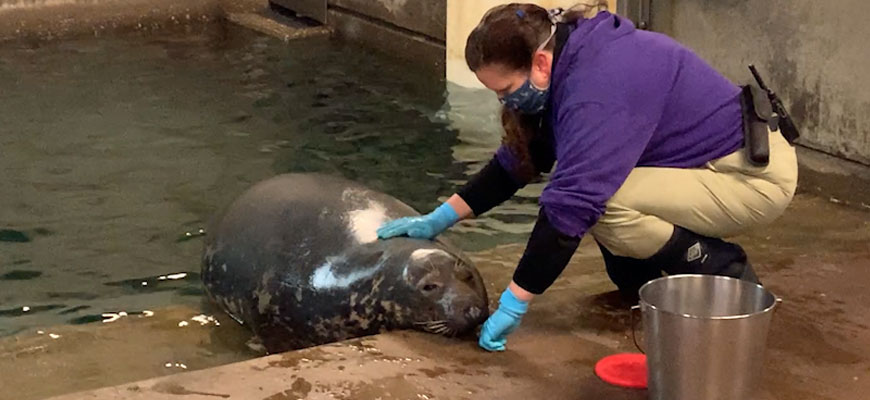CONTACT: Kyle Shepherd
502-238-5331 (Media Cell 502-744-5639)
kyle.shepherd@louisvilleky.gov
LOUISVILLE, Ky. (December 15, 2020) – Today, the Louisville Zoo announced that six-year-old gray seal, Rona, is expecting. A winter birth, between December and February, is expected. The father is 16-year-old gray seal Boone. This will be Rona’s first pup.
Gray seals are pregnant for about 11 months. For several months of the pregnancy, implantation of the embryo is delayed. This is a reproductive strategy common in many mammal species and ensures that females give birth at the same time of year along with others of their own species.
The Zoo’s veterinarians, Drs. Gyimesi and Ter Beest, have been monitoring Rona throughout her pregnancy with regular checkups and ultrasounds.
“Rona has more than doubled her weight in preparation for pupping and lactation”, says associate veterinarian Dr. Julie Ter Beest. “We’re excited to see what kind of mom she will be.”
Seal pups weigh approximately 30-35 lbs at birth and are born with a soft white hair coat called lanugo. Weaning occurs after pups nurse for only four weeks, during which time they gain approximately 100 lbs by nursing on high fat milk. By the time they are weaned, the lanugo is molted, and the pups assume adult coloration. Seal pups are not good swimmers until they have molted.
The seal pregnancy is a planned part of the Association of Zoos and Aquariums (AZA) Species Survival Plan (SSP) for gray seals. Breeding plans work to maintain the genetic diversity of managed animal populations.
The Louisville Zoo has a rich history with this species. Eight seal pups have been born at the Zoo, and when twin seal pups were born in 1979, they were the first twins to be documented in a managed system like a Zoo.
ABOUT GRAY SEALS
Gray seals are found in temperate and subarctic waters on both sides of the North Atlantic. This species can be distinguished from harbor seals by their long noses, wider set nostrils, and size, which is approximately twice as large as harbor seals. Gray seals primarily eat fish. At the Zoo, squid is a treat. Seals have good senses to help them hunt. Their underwater eyesight and hearing are excellent and they can use their long whiskers, or vibrissae, to touch objects or perceive and analyze water movements. Gray seals can sleep underwater for up to 30 minutes at a time.
***
The Louisville Zoo, a nonprofit organization and state zoo of Kentucky, is dedicated to bettering the bond between people and our planet by providing excellent care for animals, a great experience for visitors, and leadership in scientific research and conservation education. The Zoo is accredited by the Association of Zoos and Aquariums (AZA).
# # #

